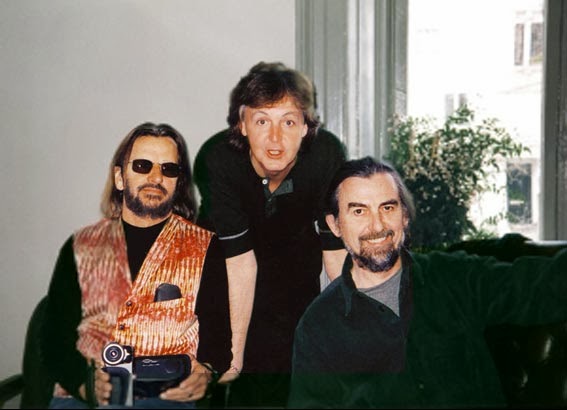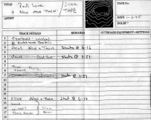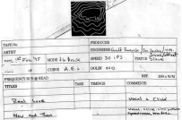Now and Then (found overdub session of Beatles song; 1995): Difference between revisions
Paulisdead (talk | contribs) (→The "last Beatles record" announcement: Lennon the musical) |
Paulisdead (talk | contribs) (→Related clips: Lennon musical video) |
||
| Line 103: | Line 103: | ||
|id2 =EPFARRffB2w | |id2 =EPFARRffB2w | ||
|description2 =Paul McCartney Confirms New Beatles Song To Be Released This Year + Discusses AI Covers - Interview. Today, BBC4 - 13 June 2023 | |description2 =Paul McCartney Confirms New Beatles Song To Be Released This Year + Discusses AI Covers - Interview. Today, BBC4 - 13 June 2023 | ||
}} | |||
{{Video|perrow =1 | |||
|service1 =YouTube | |||
|id1 =0vZ1SJjPnQ4 | |||
|description1 =''Lennon'', the bio-musical about John Lennon’s life, featured a cast performance of “Now And Then” under the title “I Don’t Want To Lose You” (at 01:19:50) | |||
}} | }} | ||
Revision as of 15:15, 15 June 2023
Now & Then (also known as "Miss You" and "I Don’t Want to Lose You") is the title of an unreleased song written by John Lennon. The song was originally recorded as a demo in 1977 with further overdubs by the surviving members (Paul McCartney, George Harrison and Ringo Starr) of The Beatles as a possible third single to The Beatles Anthology project. However, The Beatles' work on the song ceased and The Beatles' version remained unreleased.
History
John Lennon's original demo
"Now And Then" was recorded by Lennon during his "retirement" period when he was no longer a recording artist under contract and looking after his son, Sean Lennon, full time. During this time (between 1975-1980), Lennon would record numerous rough demo recordings by himself (either on guitar or piano) with nothing more than a cassette boombox. Since these were never meant to be heard by the public, audio quality wasn't a concern. The piano demo cassette recording for "Now And Then" was recorded in 1977[1]. Lennon would come out of retirement in 1980 and many of the songs during this down period were recorded professionally on the sessions for the album; Double Fantasy . On December 8th, 1980 John Lennon would be murdered. The remainder of the songs recorded would be included in the posthumously released Milk and Honey album in 1984. The song "Now And Then" was not included in the Double Fantasy sessions and would not make it past the demo stage in Lennon's lifetime.
The Beatles version
History
The Beatles' company Apple Corps, had been working on an official documentary on the band's career since 1968 (then titled The Long and Winding Road). With the band's legal issues and the death of member John Lennon delaying the project it wouldn't be until 1989 that the surviving members and Yoko Ono made plans to produce what would become the "Anthology" series. [2] During the project's production, it was decided that The Beatles would record new material for the series.
In January 1994, Paul McCartney approached Yoko Ono, Lennon's widow, believing she would have some of his unused recordings. Ono gave McCartney three cassette tapes from Lennon's retirement period, one of which was found in Lennon's New York apartment with the words For Paul written in Lennon's handwriting. The cassettes contained rough demo recordings of the songs; "Free As A Bird", "Real Love", "Grow Old With Me" (which was previously released in demo form on Milk and Honey) and "Now and Then," featuring Lennon on piano and vocals. [3]
According to Yoko Ono on why she choose "Now And Then":
"I thought, this was a song which would release people from their sorrow of losing John, by listening to the song, they will eventually be able to release their sorrow and arrive at an understanding that, actually, John is not lost to them....Paul, George and Ringo lost a great friend as well. If they sung this song from their hearts it would have helped many people around the world who felt the same."[4]
Pre-production work
Before work on "Now and Then" began, Producer Jeff Lynne (ELO, Traveling Wilburys) and engineer Marc Mann, set to work cleaning up the song. Lynne had worked on the mono cassette demos to bring them up to an acceptable quality where they could be worked on. [5] "Now And Then" proved more of a technical challenge, as a 60-cycle mains hum could be heard throughout the whole recording.
Lynne and his team spent two weeks working on cleaning up the song at his home studio. A noise reduction tool for Pro Tools called DINR was used to remove the tapes noises.
They also prepared a "Temp Track Demo". Using the MIDI sequencer Opcode Studio Vision, Lynne and Mann came up with an arrangement with drums, bass, piano and strings. The purpose of this demo was to see how a Beatles version of the song may sound and then present the ideas to the group.[6]
Lynne and Mann now had a cleaned-up version of the song on a two-track DAT tape. With the adjusted/cleaned-up Lennon recording on one track, and a 'click' track, or metronome track, on the other, to provide a strong audible guide for Ringo to add his drum rhythms to. [7]
This was then brought to Paul McCartney's Hog Hill Mill Studio in Sussex and transferred ot a 24-track reel-to-reel analog tape machine, to which other instruments were added on the remaining tracks (in fact, a second 24-track machine was 'synched-up' with the first to provide 48 tracks for recording).[8]
Recording sessions
The three remaining Beatles soon began work on all demos with Jeff Lynne producing. Work on the demos began on 11th February 1994 with "Free As A Bird", followed by work on "Now And Then" on 22nd June 1994.[9]
The DAT master for "Now and Then" was transferred to analogue 24-track multi-track[10][11]
According to McCartney, the sessions for "Now And Then" were difficult. Like "Free As A Bird", Lennon's recording of "Now And Then" was still a work-in-progress. The lyrics sung by Lennon on his demo recording weren't fully written at that stage. Lennon would fill in the missing lyrics with vocalisations as a place holder with the vocal melody. The three Beatles recorded attempted a basic backing track.
It was decided to abandon the song for the time being and focus on the more complete "Real Love". Work continued "Now And Then" in early February 1995. McCartney was keen to continue work on the song, but the sessions ended with a frustrated Harrison declaring the song "fucking rubbish". Work stopped on the recording in May 1995. [11]
Anthology singles and non-appearance of the third single
"Free As A Bird" was released as a single on 4th December 1995. It was meant with mixed reviews and missed the number 1 chart spot in the UK to Michael Jackson's "Earth Song" (to which, Jackson's record company Sony sent EMI a turkey stuffed with "Free As A Bird" singles).[12]
The next reunion single, "Real Love" was released 4th March 1996. Although critically it fared better, the chart performance was still disappointing (reaching #4 in the UK and #11 in the US). Part of the reason behind the song's performance in the UK was due to it being rejected from the BBC's Radio 1 playlist.
When it came time for the third single to be released on Anthology 3 in October 1996, the opening reunion song was replaced with an unreleased orchestral opening to the White Album track "Don't Pass Me By" titled "A Beginning". Reports in the media highlighted the technical issues Lynne and The Beatles had with recording the song but didn't rule out a future release. [5]
The main reason cited for the song's non-appearance was Harrison's dis-satisfaction with the song and the amount of work that was needed to complete it. On the Jeff Lynne Songs website, there has been a scan of a lyric sheet with complete lyrics (copyright dated to 1985) with recording notes on it.
It has also been cited in media sources that the 60-cycle mains hum was still on the recording at the time of the Beatles recording their overdubs.[13]
Post Anthology Availability
To date, no content from the overdub sessions in 1994 and 1995 has resurfaced either officially or unofficially. The original John Lennon piano demo (with the hum), later leaked via bootlegs like Miscellaneous Tracks (1995)[14] and Free As A Bird (The Dakota Beatle Demos) (1996)[15]. In 2009, a version of the cassette without the hum was circulated on the John Lennon bootleg CD At Home [16]. It has been speculated that the cleaner version was not available during the reunion sessions because it was stolen from Lennon's apartment after his death along with other cassettes and personal effects.
In 2005 the song was used the Broadway musical Lennon, under the title “I Don’t Want To Lose You”. The musical closed after a forty-one day run.
In a 2009 interview, McCartney shared his interest in completing the song with Lynne and Starr, using the archived tracks that Harrison provided before his death.
In 2012 McCartney talked about the song and Harrison's rejection during the sessions of the documentary about Lynne's career Mr Blue Sky: The Story of Jeff Lynne & ELO[11].
In a 2021 interview with The New Yorker, McCartney again mentioned his wish to finish the song as a possible "future project". [17]
As with any Beatles-related project, nothing is approved unless all four owners of Apple Corps unanimously vote in favour of it. The current owners are McCartney, Starr, Olivia Harrison (George Harrison’s widow) and Sean Ono Lennon (John Lennon’s son who took over from Yoko Ono in October 2020) [18]. Whether this has ever been discussed at Apple since the Anthology or the known stances of the other three owners is unknown.
The "last Beatles record" announcement
On the 13th June 2023 while promoting his book 1964: Eyes of the Storm on the BBC4 program Today, Paul McCartney was asked by host Martha Kearney about recent fan recreations of the Beatles music and his own voice being de-aged. In response, he briefly announced that Get Back director Peter Jackson was working with Apple on the "last Beatles record".[19][20]
When Peter Jackson did the film ‘Get Back’ where it was us making the ‘Let It Be’ album, and he was able to extract John’s voice from a ropey little bit of cassette where it had John’s voice and a piano he could separate them with AI. They could do they tell the machine ‘that’s a voice, this is a guitar, lose the guitar’s, and he did that, so he has great uses.
So we came to make what will be the last Beatles record. It was a demo that John had that we worked on and we just finished it up to be released this year. We were able to take John’s voice and get it pure through this AI, so then we could mix the record as you would normally do, you know. So it gives you it gives you some sort of leeway, so there’s a good side to it and then a scary side, and we’re just got to see where that leads.
- Paul McCartney. Today, BBC4, 13 June 2023.
While "Now And Then" was not mentioned by name, various media outlets have already begun speculating that it is the "demo" McCartney is referring to.[21]
Fan-made recreations
Since the availability of the cleaner cassette, there have been several fan edits of the song circulating on bootlegs.
Gallery
Related images
Related clips
Fan recreations
See Also
- The Threetles (lost unreleased recordings from Beatles reunion sessions; 1990s)
- The Long and Winding Road (found workprint of unfinished Beatles documentary; 1970s)
- Help! (partially found deleted scenes from The Beatles film; 1965)
- Revolution 1 (Take 20) (found mix of The Beatles song; 1968)
- Late Night Line-Up (partially found Beatles "Abbey Road" special; 1969)
- The Beatles Cartoon (partially lost skits/bumpers of animated TV series; 1965-1967)
- Carnival of Light (lost experimental Beatles song; 1967)
- Late Night Line-Up (partially found Beatles "Abbey Road" special; 1969)
- A Hard Day's Day - A Day in the Life of a Beatles Tribute Band (found parody film; 2002)
- Yellow Submarine (partially found production material for cancelled CGI remake of Beatles animated film; 2010-2011)
- The Beatles - Cavern Club tapes (partially lost recordings of British rock band; early 1960s)
External Links
References
- ↑ John Lennon - Complete Home Demo Recordings 1975-1980 Vol 1 (5CD With Slipcase) Misterclaudel. MCCD-497-501
- ↑ The Story Of The Beatles' Anthology Project - Sound On Sound
- ↑ Now And Then (song) - The Paul McCartney Project (the-paulmccartney-project.com)
- ↑ Rip Rense - August 21, 2005 - One More Beatles Song, or Should They Just Let It Be? in The Washington Post
- ↑ 5.0 5.1 The Story Of The Beatles' Anthology Project (soundonsound.com)
- ↑ Matt Hurwitz - Studio Magic: Turning Lost Lennon Tapes Into Beatle Treasure Good Day Sunshine #80 August 1996
- ↑ Matt Hurwitz - Studio Magic: Turning Lost Lennon Tapes Into Beatle Treasure Good Day Sunshine #80 August 1996
- ↑ (August 1996 - Studio Magic: Turning Lost Lennon Tapes Into Beatle Treasure article in Good Day Sunshine #80)
- ↑ "The Beatles Anthology" sessions (Feb 11, 1994 - 1996) - The Paul McCartney Project (the-paulmccartney-project.com)
- ↑ https://www.soundonsound.com/people/story-beatles-anthology-project The Story Of The Beatles' Anthology Project-Sound On Sound article from 1995 explaining the technical details of the reunion sessions.
- ↑ 11.0 11.1 11.2 Mr Blue Sky: The Story of Jeff Lynne & ELO. BBC. 2012
- ↑ The Story of... 'Earth Song' by Michael Jackson - Smooth (smoothradio.com)
- ↑ Jack Malvern (April 9, 2005 - The Times)
- ↑ https://www.discogs.com/master/1342756-John-Lennon-Miscellaneous-Tracks Miscellaneous Tracks
- ↑ https://www.discogs.com/master/705246-John-Lennon-Free-As-A-Bird-The-Dakota-Beatle-Demos Free As A Bird (The Dakota Beatle Demos)
- ↑ John Lennon – At Home (2009, CD) - Discogs
- ↑ Paul McCartney Doesn’t Really Want to Stop the Show | The New Yorker
- ↑ Sean Lennon has taken control of John Lennon’s estateCosmic Magazine
- ↑ https://www.bbc.com/news/entertainment-arts-65881813 Sir Paul McCartney says artificial intelligence has enabled a 'final' Beatles song. BBC Music
- ↑ https://abcnews.go.com/GMA/Culture/paul-mccartney-reveals-ai-create-beatles-record/story?id=100052489 Paul McCartney reveals AI was used to create the 'last Beatles record'
- ↑ https://www.bbc.com/news/entertainment-arts-65881813 Sir Paul McCartney says artificial intelligence has enabled a 'final' Beatles song. BBC Music



